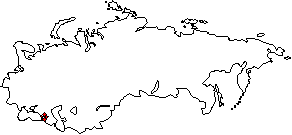CONTENTS
IntroductionForeword
Language Groups
Tribes and Dialects
Order the book
The Peoples
of the Red Book
Abazians (Abaza)Abkhaz
Aguls
Akhvakhs
Aleuts
Altaics
Aliutors
Andis
Archis
Asiatic Eskimos
Bagulals
Baraba Tatars
Bartangs
Bats
Bezhtas
Botlikhs
Budukhs
Central Asian Jews
Chamalals
Chukchis
Chulym Tatars
Crimean Jews
Crimean Tatars
Didos
Dolgans
Enets
Evens
Evenks
Georgian Jews
Godoberis
Hinukhs
Hunzibs
Ingrians
Ishkashmis
Itelmens
Izhorians
Kamas
Karaims
Karatas
Karelians
Kereks
Kets
Khakass
Khants
Khinalugs
Khufis
Khvarshis
Kola Lapps
Koryaks
Kryz
Kurds
Lithuanian Tatars
Livonians
Mansis
Mountain Jews
Nanais
Negidals
Nenets
Nganasans
Nivkhs
Nogays
Orochis
Oroks
Oroshoris
Peoples of the Pamirs
Roshanis
Rutuls
Selkups
Shors
Shughnis
Tabasarans
Talysh
Tats (Tatians)
Tindis
Tofalars
Trukhmens (Turkhmens)
Tsakhurs
Udeghes
Udis
Ulchis
Veps
Votes
Wakhs
Yaghnabis
Yazgulamis
Yukaghirs

THE GEORGIAN JEWS
Habitat. The Georgian Jews live mostly in the eastern part of Georgia, in Tbilisi and other surrounding towns and small country villages. The European Jews keep to the towns.
Population. In 1926 there were about 20,000 Georgian Jews. It is difficult to establish an exact number, because in the censuses they have not been counted separately from other Jews. In "The Atlas of the Peoples of the World", published in 1964, the number of Georgian Jews is given as 35,700.
Language. The Georgian Jews long ago adopted the Georgian language.
Anthropologically, they do not differ from the eastern Georgians, who belong to the Armenian type of the Balkano-Caucasian race. In former times they trimmed their hair and beards in a slightly different way to that of the Georgians. They were also more often red-headed.
Origin. These Jews are considered to be ancient inhabitants of Georgia, and according to old Georgian manuscripts they settled there in the first centuries AD. This hypothesis is supported by archaeological finds. Culturally, the Jews have gradually grown close to the Georgians (i.e. the adoption of the language), though their ethnic identity has been maintained in their religion -- Judaism. The Jewish cultural sphere related to Judaism has always had its peculiarities (cf. Mountain Jews and Central Asian Jews). Jewish isolation has been preserved over many centuries by persecution and restrictive customs; for instance, Jews were not allowed to marry Georgians. Therefore religion and religious leaders (rabbis or hahamis) have played an important role in the social life of the Georgian Jews.
There has been no research on the present-day Georgian Jews.
REFERENCES
- И. Пульнер, Итоги и задачи изучения кавказских (грузинских и горских) евреев. -- Советская этнография 4--5, 1936
- С. А. Токарев, Этнография народов СССР, Москва 1958
IT